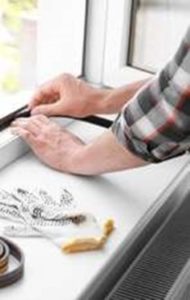Drafts in your home cost money
With cold temperatures, we became acutely aware of how well our homes keep us warm in the winter months. It also makes us aware of how drafts in your home may be working against us as we are trying to keep our living areas comfortable. In fact, it is easier to discover draft creating leaks in our home’s structure in very cold weather than it is in hot Summer months. Mostly, the drafts are easier to detect in the cold because of the large temperature difference of the outside and inside air (Winter may have 20 degrees outside and 70 inside, which creates a 50 degree differential, while in the summer 95 degrees outside and 70 inside is only a 20 degree differential)
In Texas, we aren’t always prepared for the super-cold weather. However, just because you have to fight the chill outside, doesn’t mean you should have to battle it inside as well. If your heating system is on and you’re still having to bundle up, you probably have a drafty home. The problem with a drafty home does not stop and start with your discomfort. A draft means cool air is coming in, while warm air is escaping, creating a vicious cycle of wasted energy and consequently money out of your pocket.
Where drafts are most common?
- Window frames
- Exterior doors
- Baseboards
- Electrical outlets
- Fireplace / chimneys
- Recess lighting
- Improperly insulated attic or garages

Five Ways to Detect a Draft
Five tried-and-true methods for discovering drafts around your home include:
1 Flashlight – Grab a partner and go outside when it’s dark. Shine the light through the door or window frame and if the person on the other side sees it, there is a leak.
2 Paper Test – Slip a piece of paper under the door frame, if you feel no resistance pulling it back there is a leak.
3 Candle or Incense – Can be used for the non-door and window related issues. First, turn off your furnace and water heater and turn on any nearby exhaust fans. Hold a candle or stick of incense near any suspected problem area, if the flame flickers or smoke from the incense blows sideways, there is a leak.
4 Use Your Senses – When you stand near a door or window do you feel a soft breeze? Can you hear a soft whistling noise when your doors and windows are shut? If so, there’s a leak.
5 Call in a Professional – Our HVAC techs carry thermal leak detection devices that can accurately spot leaks. They’ll also be able to point you in the right direction for leak repair.

6 Simple Solutions for Draft Repair
1 Lock Your Windows – This might seem obvious but it’s a common issue that is often overlooked. Unlocked windows are not fully sealed, allowing unwanted cold air to seep in.
2 Seal Windows – Lack of proper sealing is poor defense against the chill. You can use weather stripping or caulk to seal any unwanted gaps and leaks.
3 Invest in Curtains – Insulating curtains exist for this very reason, just make sure to open them up when the sun is shining to utilize the sun’s natural heat.
4 Use a Door Sweep – If the bottom of your doors is your biggest concern, these draft blockers are an easy and effective fix.
5 Install Storm Doors – Storm doors are a great barrier for wind and harsh weather.
6 Insulate – Have a professional evaluate your garage and attic for proper insulation.
Your home should be a place of refuge against the cruel winds of winter. Win the war against drafts and enjoy a cozy home this winter.



